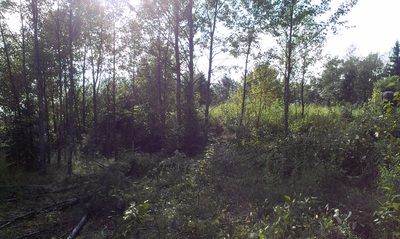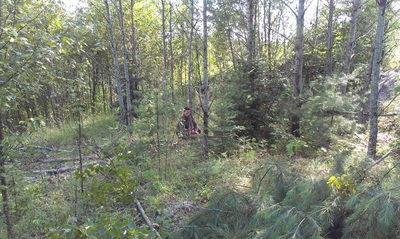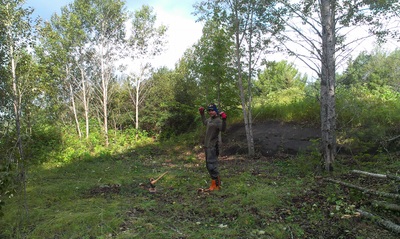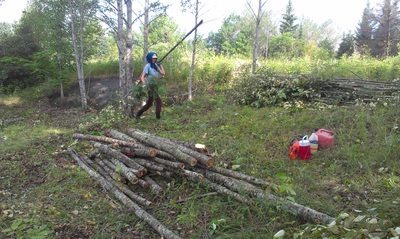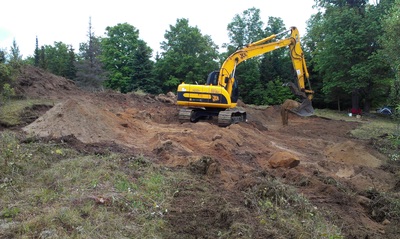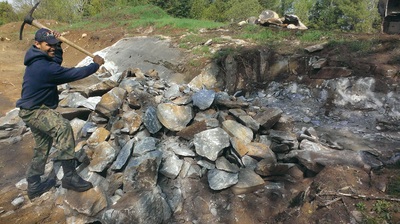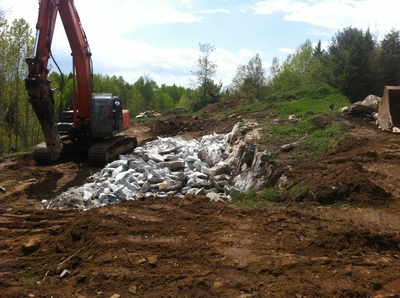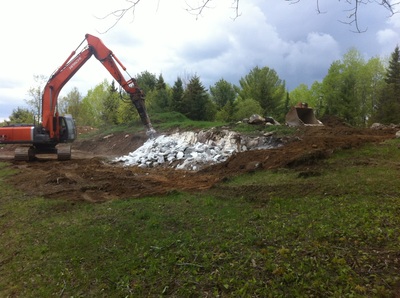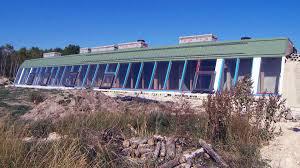 Manitoba Earthship
Manitoba Earthship
There are many different types of
ecological, sustainable buildings out there. Popular ones take
advantage of passive solar, straw bale, rammed earth, cordwood and so
on. According to our research we have found that all buildings have
their benefits and set-backs – from various perspectives. For example,
taking into account the embodied energy
in some of the materials themselves can seem fairly ‘unsustainable.’
Some buildings require more maintenance then others. Others still
depend heavily on exterior utility supplies. The building that appealed
to us the most is called an Earthship. Scroll down for a quick 5 min video describing visually how the earthship is built and the systems involved if you don't feel like reading.
What on earth is an Earthship?
Earthships are sustainable housing solutions created from recycled materials and powered by renewable energy sources. The principle of the Earthship is such that it can be designed to suit any climate in the world, be economical and self-sustaining. Globally there are over 1000 Earthships in operation.
An Earthship is a type of passive solar house made primarily of natural and recycled materials. Designed and marketed by Earthship Biotecture of Taos, New Mexico, the homes are primarily constructed to work as autonomous buildings and are made of rammed earth tires, using thermal mass construction to naturally regulate indoor temperature. They also have their own special natural ventilation system. Earthships are generally off-the-grid homes, minimizing their reliance on public utilities and fossil fuels. Earthships are built to utilize the available local resources, especially energy from the sun. For example, windows on sun-facing walls admit lighting and heating, and the buildings are often horseshoe-shaped to maximize natural light and solar-gain during winter months. The thick, dense inner walls provide thermal mass that naturally regulates the interior temperature during both cold and hot outside temperatures.
Source: https://sites.google.com/site/earthshipmanitoba/project-definition
Six Design Principles of an Earthship:
Earthships are thermal mass homes first, passive solar homes second. Therefore, the layout and design of the Earthship can be completely customized to look like any conventional home, and still be sustainable.
If you want heat, you admit the sun. The sun heats the mass, the mass stores the heat and the insulation won't let it escape. The more mass, the more storage capacity. When there is no sun, the heat stored in the mass radiates into the space, for heat travels to the cooler direction.
If you want coolness, you admit the cooler earth temperature and block the sun. The cool mass of the earth connects with the mass of the shelter, is absorbed into the shelter mass and leaks into the living space. This is like hooking a big battery (the earth) up to a smaller battery (the shelter). The thermal mass of both the earth and shelter is a storage battery for temperature.
Earthships produce their own electricity with a prepackaged photovoltaic / wind power system. This energy is stored in batteries and supplied to your electrical outlets. Earthships can have multiple sources of power, all automated, including grid-intertie.
Earthships contain, use and reuse all household sewage in indoor and outdoor treatment cells. This results in food production and landscaping with no pollution of aquifers. Toilets flush with treated gray water that does not smell.
The major structural building component of the Earthship is recycled automobile tires filled with compacted earth to form a rammed earth brick encased in steel belted rubber. This brick and the resulting bearing walls it forms is virtually indestructible.
Water is caught from a roof with a potable surface. From the roof, the water is channeled through silt catches into cisterns. Cisterns are sized to the local climate and are best buried and completely protected from the sun. The water from the cistern is gravity-fed into a Water Organizing Module with a pump and filter. The pump pushes the water into a pressure tank to supply code required water pressure. The filters clean the water for consumption and cleaning.
Earthships create an environment in which plants are not only asthetic and contributing to the heath of our environment, but are also highly functional and play a direct role in the maintenance of the home. Having plants that produce food within this environment makes sense and takes sustainable and independent living to another level.
Source: http://earthship.com/Systems/
Here is a quick 5 min video describing visually how the earthship is built and the systems involved.
What on earth is an Earthship?
Earthships are sustainable housing solutions created from recycled materials and powered by renewable energy sources. The principle of the Earthship is such that it can be designed to suit any climate in the world, be economical and self-sustaining. Globally there are over 1000 Earthships in operation.
An Earthship is a type of passive solar house made primarily of natural and recycled materials. Designed and marketed by Earthship Biotecture of Taos, New Mexico, the homes are primarily constructed to work as autonomous buildings and are made of rammed earth tires, using thermal mass construction to naturally regulate indoor temperature. They also have their own special natural ventilation system. Earthships are generally off-the-grid homes, minimizing their reliance on public utilities and fossil fuels. Earthships are built to utilize the available local resources, especially energy from the sun. For example, windows on sun-facing walls admit lighting and heating, and the buildings are often horseshoe-shaped to maximize natural light and solar-gain during winter months. The thick, dense inner walls provide thermal mass that naturally regulates the interior temperature during both cold and hot outside temperatures.
Source: https://sites.google.com/site/earthshipmanitoba/project-definition
Six Design Principles of an Earthship:
Earthships are thermal mass homes first, passive solar homes second. Therefore, the layout and design of the Earthship can be completely customized to look like any conventional home, and still be sustainable.
If you want heat, you admit the sun. The sun heats the mass, the mass stores the heat and the insulation won't let it escape. The more mass, the more storage capacity. When there is no sun, the heat stored in the mass radiates into the space, for heat travels to the cooler direction.
If you want coolness, you admit the cooler earth temperature and block the sun. The cool mass of the earth connects with the mass of the shelter, is absorbed into the shelter mass and leaks into the living space. This is like hooking a big battery (the earth) up to a smaller battery (the shelter). The thermal mass of both the earth and shelter is a storage battery for temperature.
Earthships produce their own electricity with a prepackaged photovoltaic / wind power system. This energy is stored in batteries and supplied to your electrical outlets. Earthships can have multiple sources of power, all automated, including grid-intertie.
Earthships contain, use and reuse all household sewage in indoor and outdoor treatment cells. This results in food production and landscaping with no pollution of aquifers. Toilets flush with treated gray water that does not smell.
The major structural building component of the Earthship is recycled automobile tires filled with compacted earth to form a rammed earth brick encased in steel belted rubber. This brick and the resulting bearing walls it forms is virtually indestructible.
Water is caught from a roof with a potable surface. From the roof, the water is channeled through silt catches into cisterns. Cisterns are sized to the local climate and are best buried and completely protected from the sun. The water from the cistern is gravity-fed into a Water Organizing Module with a pump and filter. The pump pushes the water into a pressure tank to supply code required water pressure. The filters clean the water for consumption and cleaning.
Earthships create an environment in which plants are not only asthetic and contributing to the heath of our environment, but are also highly functional and play a direct role in the maintenance of the home. Having plants that produce food within this environment makes sense and takes sustainable and independent living to another level.
Source: http://earthship.com/Systems/
Here is a quick 5 min video describing visually how the earthship is built and the systems involved.
Our progress so far:
We began designing around December 2013. It has been an ongoing process since then but in the mean time – when the ground is not frozen and covered in snow – we have been preparing the building site. This has entailed some light tree clearing, an initial excavation and some rock breaking and removal. Andrés felt strongly from the very beginning where he thought the house should go. The site is at the top of the ridge, southfacing, looking down to a valley that you pass by as you enter the driveway. The ground there seemed to form a natural plateau – quite small at first sight but once we cleared the trees, then brought the excavator which did some minor scraping of top soil, we could see that the area was a perfect rectangle waiting for us to build our future home. Initially, we wanted to incorporate a gorgeous stretch of rock (aka the Canadian Shield) that lined the north side of the site into the house. Meaning it would form the north interior wall of our living room. However (and this is where designing/planning gets delayed!) after some research and discussion with engineering experts we decided this would cause temperature and moisture issues in the long run. Bailing on this idea meant that if we didn’t remove this rock our interior floor space would be heavily reduced as the tires and backfill we’ll be adding in front of the rock take a lot of room! So there you go – an unexpected expense and a sore site to watch thousands of years of rock formation being chipped away by a big scary machine. Yet these are the decisions and experiences I guess one goes through when embarking on such a project.
